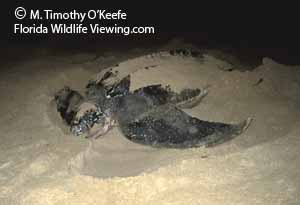Essentials
Home
Where to Go
When to Go
Animal Facts
Photo Gallery
Photo Tips
Kids' Corner
______________
Activities
Florida Birding
Birding Optics
Florida Camping
Kayaking
Nature Festivals
Florida Hiking
Nature Webcams
______________
Florida Travel
Florida Ecotourism
Travel Insurance
Florida Maps
Florida Weather
___________
About Us
Disclaimer
Copyright Notice
Site Search
|
|
Do Sea Turtles
Really Return
To Their Birthplace?
Sea turtle mating may take place on the ocean bottom, the surface or in
open water. Mating occurs about 30 days before the
females begin nesting. The early season matings will fertilize an entire
season's eggs.
It's
a common assumption that sea turtles nest on the same
beach where they were hatched. This is not a known certainty
since it's impossible to track a turtle from the time it hatches until
it returns to nest. (See Nesting Sea Turtle Photos)

Has this sea turtle really returned to the
beach it left as a hatchling?
However,
once a turtle begins to use a specific beach for nesting,
she does appear to return to the same beach season
after season.
Since turtles often winter hundreds of miles from their nesting
beaches, it is a mystery how they find their way back year after year.
Perhaps
they follow a special taste or smell that is unique
to each region of the ocean or coastline, or they may navigate by the
earth's magnetic fields. It's likely sea turtles employ
a combination of senses to form their natural guidance
system.
Another
common misconception is that females tend to deposit
their eggs around the time of the full moon. The theory
is that the full moon creates a higher tide, which in turns will better
hide the nesting trails.
Excellent
logic, but it doesn't appear to be true. Turtles nest during all
phases of the moon, with cycles of 10 to about 17 days between
nestings.
Turtle eggs incubate for about 60 days. The hatchlings normally
break out of the nest at night. The daytime heat could be fatal to hatchlings,
especially if they did not find the sea immediately. The cool of the
night is safer, plus the cover of darkness foils many
predators.
Life is a precarious for hatchlings since their small size
makes them easy prey for birds and fish. They seem to recognize this
since they totally disappear their first year of life.
Scientists cannot agree where the hatchlings go until they reach eight to 10 inches in
length. Leatherbacks and ridleys are rarely seen until they mature.
To Page 4, Endangered Sea Turtles
To Where to See Nesting Sea Turtles
To Sea Turtle Homepage
To Florida Animals & Wildlife Home
|
|

